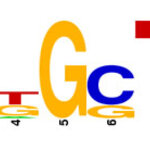Genetics & Molecular Biology

How proteins recognize specific stretches of DNA is one of the key questions of gene regulation. One would like to be able to look at the regulatory DNA sequence adjacent to a gene, and predict which regulatory proteins bind there, and control the adjacent gene. In other words, we want to, just by running a few computer programs over a genome, know how the genes in that genome are regulated.
A group of researchers, led by Martha Bulyk (Harvard) and Tim Hughes (Toronto) have been working towards a near-comprehensive index of DNA sequence specificities for DNA-binding proteins. The goal is to…

An interesting phenomenon in growing random networks:
The number of 3-node, 3-edge connected subgraphs in a random, scale-free network of N nodes scales as N0 (=1). No matter how big your network grows, you're going to have a roughly constant number of 3-node, 3-edge subgraphs that depends only on the ratio of edges to nodes.
Let's back up a minute before we see why this counterintuitive result is so and what it means. Imagine that we have a network made up of N nodes connected by E edges. You can start out with two nodes connected by one edge:
Your edge-node ratio here is…

The Database of Useful Biological Numbers - great stuff, although before using any hard-to-measure number, be sure to know how the measurement was done before you trust the result.
Check these out:
Number of hairs in human eyebrows: 600
Respiratory cost for slow growing gradd: 2.4 mmole ATP/g dry weight * day
ATP requirement for the creation of an E. coli cell: 12-20 billion ATP molecules.
Average diameter of a protein in E. coli: 5 nm
Fraction of total body energy that is used to drive sodium/potassium pumps in the human brain: 10%
Serotonin content in pineapple: 17ug/g
Total nasal…

DNA is like your phone line. As Northwestern University biophysicist Johnathan Widom put it in a talk recently, DNA simultaneously encodes multiple overlapping signals, just like your phone line that allows you to call home while you're surfing the net via DSL. Written into your DNA is the code for the amino acid sequences of the proteins produced by your genes, as well as the so-called 'non-coding' regulatory sequences which essentially encode when, where, and how much your genes are expressed.
On top of all of this, there is another code - not so explicitly defined as the genetic code, but…

It's easy to get lost in a eukaryotic cell. Proteins need to be in the right place at the right time to carry out their functions, but the cell is a crowded place, and the layout isn't exactly simple. Fortunately, the cell has a fairly sophisticated transportation system: if you need to head out of the cell, take the secretory pathway; if your job is to regulate genes, the nuclear shuttle will take you where you need to go.
The protein Htb2 hanging out exactly where it is supposed to be - the nucleus
But how does a protein get on the right track? It all comes down to binding interactions:…

Darwin didn't miss much, I think we all agree, and came up with a lot given the limited science of his day. One thing he missed, that by this time tomorrow will be the source of outrageous titles from every schlock science publication in existence, was that sexual selection that goes on even after actual sex.
Confusing? It's not so difficult to understand. Some female critters are trampy and have sex with more than one guy, for example (what, you think other parts of the animal kingdom don't have Jenna Jameson?) so there's sperm competition but there are also other…

Darwin knew that some mechanism had to govern how our physical features and behavioral traits have evolved over centuries, passing from a parent to their offspring with natural selection favoring those that give the greatest advantage for survival, but he did not have a scientific explanation for this process.
Scientists for decades have believed that differences in the way genes are expressed into functional proteins is what differentiates one species from another and drives evolutionary change but no one has been able to prove it - until now, say researchers at the University of Leeds.
In…

You age. As you age, your cells age. Your telomeres wear out. Even single-celled yeast age, giving birth to only a limited number of daughter cells. So how is it that each new generation starts fresh, unaged?
This is a great mystery - part of which is explained by the fact that your germ cells (which later turn into sperm and egg), those cells that will produce the next generation, are preserved with extra special care right from the start of your embryonic development. The non-germ cells, called somatic cells, make up all of the rest of you, and they age.
Stay tuned for a longer discussion…

I'm mixing my movie references with the headline, perhaps, but it's honestly the first thing that popped into my head when I read about a worm helping scientists understand longevity.
Perhaps an explanation is in order. Nicholas Wade writes in the NY Times that germ cells (egg and sperm) are, so to speak, immortal. "A little piece of the germline’s immortality, it now seems, can be acquired by the ordinary cells of the body, and used to give the organism extra longevity."
Researchers know that manipulating the insulin-signaling pathway can affect lifespan, similar to the way…

Boys who carry a particular variation of the gene Monoamine oxidase A (MAOA), called the 'warrior' gene by some, are more likely to join gangs and be among their most violent members, according to a study from a Florida State University criminologist that associates MAOA to gangs and guns.
Findings apply only to males, which makes an unsubstantiated allele argument necessary. Girls with the same variant of the MAOA gene don't show any propensity toward gang membership or weapon use. MAOA has also been implicated in ADHD, bipolar disorder, cancer and smoking. Basically…